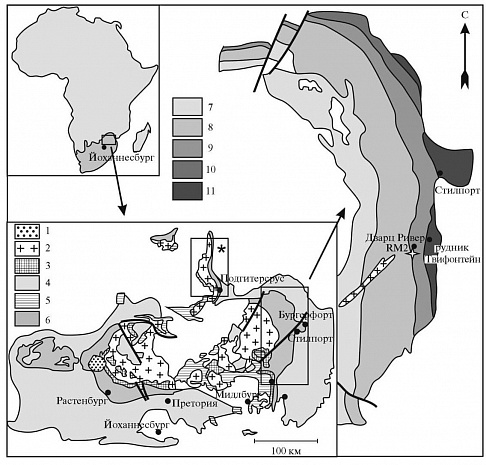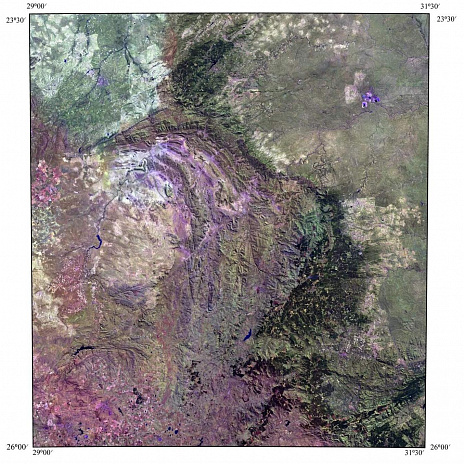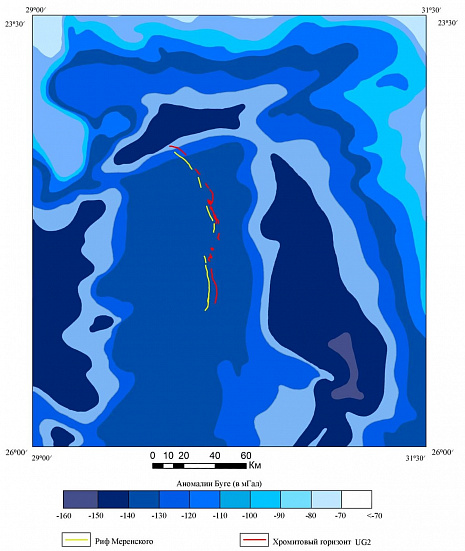Sat-Sun: Non-working days
Research on the differentiated Bushveld Complex (South Africa) has been conducted using remote sensing and gravimetric methods. The potential use of multispectral satellite imagery from Landsat 7 ETM+ and brightness characteristics for platinum group metal (PGM) prospecting in new prospective areas has been demonstrated. Analysis of gravity field values revealed that PGM mineralization in the studied area is concentrated within a narrow range of values, making these data suitable as exploration indicators. Key conclusions have been formulated, highlighting the capabilities of Landsat 7 ETM+ multispectral satellite imagery for PGM prospecting in new prospective areas. The study results demonstrate the effectiveness of integrating remote (satellite-based) and geophysical methods to enhance the approach to exploration for platinum-copper-nickel ore deposits.
Currently, the development of methods for comprehensive computer processing of gravimetric survey data and remote sensing of the Earth is highly relevant for predicting platinum group metal-nickel-copper ore deposits in new areas. The Bushveld Complex (South Africa) serves as a benchmark source of information in developing forecasting methods and exploring new platinum group element (PGE) deposits worldwide [Magmatic..., 1973]. Within its boundaries, over 80% of global PGE reserves and approximately 88% of platinum reserves are concentrated. These reserves are associated with three main reef levels: the chromitite UG2 horizon, Merensky Reef, and Platreef [Lazarenkov, 2002].
The main centers for PGM mining are located within the most studied Western sector of the Bushveld Complex (Atok, Rustenburg, Union, Bafokeng, Amandelbult, Messina, Marikana, etc.) [Milovsky et al., 2016]. Deposits in the Eastern sector (Brakfontein, Witerweld, Onverwacht, Twickenham, Richmond, Der Brochen) are characterized by PGM content in ores ranging from 4 to 7 g/t [Du Toit, 1954].
Based on examples from ore deposits in the Eastern sector of the Bushveld Complex, the development of methods for computer processing of gravimetric survey data and remote sensing of the Earth is highly relevant for predicting platinum group metal-nickel-copper ore deposits in new areas.

The relevance of large-scale prediction and exploration of mineral resources using remote (satellite and magneto-gravimetric) methods is due to the need to obtain qualitatively new data on studied objects without incurring the costs of expensive fieldwork [Kronberg, 1988; Chandra, 2008; Shvengardt, 2010].
Currently, there is a wide range of theoretical and practical developments on the integrated application of remote geophysical and satellite methods for oil and gas deposits, while publications on the integration of geophysical and satellite methods in the field of solid minerals are significantly fewer. Research on identifying platinum group metal-nickel-copper deposits based on remote methods represents a significant scientific and practical interest.
Geological characteristics of the area.
The Bushveld Complex (South Africa) is located in the northern part of the Kaapvaal Craton in the center of the Rand dome, formed by volcano-sedimentary deposits of the Dominion Reef, Witwatersrand, Ventersdorp, and Transvaal series (Fig. 1).
The total area of the pluton is about 6000 km2, with a thickness reaching 9000 m. The entire complex consists of four apparently independent parts; a fifth part is buried under younger sedimentary deposits [Geology..., 1973]. The considered magmatic complex is a benchmark in the group of rhythmically layered massifs, and it is here that over 80% of the world's PGM reserves and approximately 88% of platinum reserves are concentrated. These reserves are associated with three main horizons: the chromitite UG2 horizon, the Merensky Reef, and the Platreef. The main centers for PGM mining are located within the most studied Western sector of the Bushveld Complex. Deposits in the Eastern sector are currently actively being explored and prepared for industrial development. Therefore, predicting PGM mineralization in the Eastern sector of the Bushveld Complex presents significant scientific and practical interest.
The Bushveld Complex includes several series of volcanic rocks, the sequence of formation of which is established based on geological and geochronological data [Cawthorn et al., 2002]. The first phase of intrusion is considered to be basaltic sills in the base of the enclosing rocks. This is followed by an explosive phase, which formed the andesite-dacite-rhyolite thickness of the Roiberg Group, which currently forms the roof of the layered series. The next intrusive phase is the Rustenburg ultrabasic-basic layered series, up to 8 km thick, whose rocks are intruded by ultrabasic pipes, as well as late dolerite dikes and sills.
Within the Rustenburg series, platinum-bearing reefs are traced—the chromitite UG2 horizon, the Merensky Reef, and the Bastard Reef, which are extensive horizons of magmatic rocks with rich ore mineralization [Willems, 1973].
Later, possibly as a result of the melting of the roof of the Rustenburg layered series, the formation of granophyres of the Rashoop group occurred. The concluding phase is considered to be the Lebowa granites, which overlay the Rustenburg layered series in the central part of the complex and form bodies up to 3 km thick beneath the roof of the Royberg group volcanic rocks.
The intrusion of all these magmatic formations covers a relatively narrow interval of 1–1.5 million years (2054.4 ± 1.3 million years, according to [Scoates and Freidman, 2008]; Zeh et al., 2015]). According to the zoning scheme accepted for the territory of the Bushveld Complex, the western, eastern, northern, far western, and southeastern limbs are distinguished. The cross-sections of magmatic series in all these areas have specific characteristics [Cawthorn, 2002]. Within the Rustenburg ultrabasic-basic layered series, the following zones are distinguished (from bottom to top): Basal, Critical, Main, Upper. The Critical Zone hosts half of the world's chromium reserves, as well as three platinum-bearing reefs. The 1.5–2 km thick Critical Zone is divided into upper and lower subzones, with the boundary between them established based on the first appearance of cumulus plagioclase in the section. The lower subzone is dominated by pyroxenites with a small amount of garnet-rich and chromitite horizons. The upper subzone is represented by interlayered pyroxenites, norites, anorthosites, and chromitite horizons. The platinum-bearing chromitite horizon UG2 is traced in the upper part of the Critical Zone. Above the UG2 horizon lies the Merensky Reef, with thickness varying from 40 cm to 6 m in different sections of the Bushveld Complex [Kinnaird et al., 2004].
The Merensky Reef is a unique horizon of plagioclase pyroxenites (often pegmatoidal), where minerals of platinum metals, gold, and silver are concentrated, associated with sulfide mineralization [Naldrett, 2004; Налдретт, 2003]. The reef is traced in the upper Critical Zone at the boundary with the Main Zone of the Rustenburg ultrabasic-basic layered series.
Materials and methods of research. Deciphering of materials from satellite imagery. Development of methods for computer processing of gravimetric, magnetometric, and satellite survey data was carried out to establish patterns of platinum-metal mineralization localization in the Eastern sector of the Bushveld Complex based on the study of materials from multispectral satellite survey Landsat 7 ETM+ in combination with analysis of geological and geophysical maps of the region. Data processing was performed using specialized software products ENVI, ArcGIS, and Adobe Photoshop (Fig. 2).
To address questions related to the recognition of geological objects against the background of host rocks and to assess their potential ore-bearing capacity, the capabilities of multispectral satellite survey LANDSAT 7 ETM+ were investigated. The choice of satellite survey for the study is justified by the fact that the compilation of State Geological Maps of Russia at a scale of 1:1,000,000 of the third generation is mandatory and is based on digital materials of LANDSAT 7 ETM+ [Methodological Guide..., 2009; Requirements..., 2012].
For the analysis of LANDSAT 7 ETM+ data results, brightness characteristic values in channels were used: 1 (0.45–0.52 μm, visible), 2 (0.52–0.60 μm, visible), 3 (0.63–0.69 μm, visible), 4 (0.76–0.90 μm, near infrared), 5 (1.55–1.75 μm, mid infrared), 6 (10.40–12.5 μm, thermal), 7 (2.08–2.35 μm, mid infrared), 8 (0.52–0.90 μm, panchromatic). Processing of digital materials from satellite survey was carried out using specialized software ENVI 4.8, allowing for the complete processing cycle from spatial image registration to obtaining necessary information.
Deciphering features refer to the properties of objects that directly or indirectly are reflected in the images and ensure the recognition of objects.

The use of decoding features forms the basis of visual interpretation of images, which, along with measurements, is the primary method for extracting information from images. Properties of objects directly represented on images are referred to as direct decoding features. These include three groups of features: geometric (shape, shadow, size), brightness (phototone, brightness level, color, spectral pattern), and structural (lineament analysis).
Results of Research and Their Discussions.
Regional structures, linear and arcuate faults were identified through space structural decoding. Within the Eastern sector of the Bushveld Complex, fault structures (complexly constructed lineament zones) were identified, determining the spatial position of the Merensky Reef.
This is due to the fact that the Bushveld Lopolith, judging by its morphological parameters (extent from west to east 480 km and thickness of about 9 km, with a length-to-thickness ratio of 53:1), would more accurately be termed a supersill, jointly filling the compensatory brachy-syncline with the Transvaal Sequence. A residual acidic melt, which intruded later through the same channels and likely from the same magmatic center, penetrated the roof of crystallized norite lopolith, forming the so-called Bushveld red granite. Its mass induced centrifugally oriented stress in the peripheral endo- and exo-contact zones of the norite lopolith. As a result, a system of low-amplitude faults of shear kinematic type developed in these zones, accompanied by the formation of radial fracturing. Along radial disjunctives, both the chromitite horizon and the Merensky Reef were disrupted and displaced in many places, as recorded in the analysis of geophysical fields and in the interpretation of satellite imagery materials [Milovsky, 2016].
During the decoding of multi-zone satellite images Landsat 7 ETM+ of the Eastern sector of the Bushveld Complex, numerous displacements of the platinum-bearing Merensky Reef along the system of linear discontinuities of northeast extension were identified. The spatial position of the Merensky Reef is determined by local lineaments, clearly identified from the materials of multi-zone satellite survey Landsat 7 ETM+ and during the interpretation of geophysical fields. Analysis of the gravity field map has established that within the study area, platinum-metal mineralization is concentrated in the region of gravity field values from 70 to 120 mGal (Fig. 3).

DN values are dimensionless and proportional to the amount of radiation hitting the sensor and characterize the energy flux (watts) per square meter of the Earth's surface per one steradian (three-dimensional angle from a point on the Earth's surface to the sensor) per unit of measured wavelength [Schowengerdt, 2010]. The spatial resolution of channels 1-5 and 7 is 30 meters, channel 6 is 60 meters, and channel 8 is 15 meters.
The possibility of disassembling the rocks of the norite complex on the basis of remote sensing materials in the area of the Eastern sector of the Bushveld complex was shown (Fig. 3). According to the geological map of scale 1:1,000,000, taking into account the space imagery data, the following areas were selected: 1 - Upper zone; 2 - Main zone; 3, 4 - Critical zone with and without chromitite interlayers; 5 - Basal zone. As a result of evaluation of brightness characteristics using Fisher and Student's criteria it was established that channel 2 (0.52-0.60 microns, visible) is the most informative for rock sorting. All areas were compared in pairs based on statistical criteria to determine the significance of brightness differences in the LANDSAT 7 ETM+ CW bands. All calculations were performed with the significance level α =0.01, which corresponds to 99% confidence probability of the validity of the obtained conclusions [Ishmukhametova, 2015]. F-criterion, based on the comparison of dispersions:


If the computed t-test value was greater than the tabular value at a significance level of α = 0.01, the difference between the two samples of this range of satellite imagery was considered significant. Synthesis of Landsat 7 ETM+ spectral ranges and the characteristics of brightness in individual ranges allow identification of the aggregate of norite complex rocks against the background of overlying and underlying rocks. Additionally, it allows for the classification of norite complex rocks into Basal, Critical, Main, and Upper zones.
The data obtained from the Eastern sector of the Bushveld Complex reveal new opportunities for improving methods of forecasting and prospecting for platinum-copper-nickel deposits. It should be noted that large, long-lived fault structures (complexly constructed deep-seated lineament zones) played a significant role in the structure of ore-forming systems, controlling the periodic influx of fluids-heat carriers and associated substances, including ore components [Gruenewaldt von, 1973]. Thus, the use of multi-zone Landsat 7 ETM+ imagery for geological studies has enabled determination of rock compositions, geological boundaries, and structural-tectonic mapping, reconstructing geological structures. The developed methodology can be used for geological research in other poorly studied areas with similar geomorphological and landscape-climatic conditions.
Conclusions
-
It was established that within the study area, platinum-metal mineralization is concentrated in the gravity field values ranging from -70 to -120 mGal.
-
Within the Eastern sector of the Bushveld Complex, space structural decoding indicates the presence of post-rupture fault structures (complexly constructed lineament zones), which often determine the spatial position of the Merensky Reef.
-
Synthesis of Landsat 7 ETM+ spectral ranges and the characteristics of brightness in individual ranges allow for the identification of the aggregate of norite complex rocks in the Eastern sector of the Bushveld massif against the background of overlying and underlying rocks, and furthermore, allows for the breakdown of norite complex rocks into Basal, Critical, Main, and Upper zones.
-
For forecasting platinum-metal ore deposits in new prospective areas, it is advisable to use multi-zone Landsat 7 ETM+ satellite imagery and brightness characteristics.
References
1. Geology and Mineral Resources of Africa. Moscow: Nedra, 1973. 544 p.
2. Ishmukhametova V.T. Forecasting of primary diamond deposits on the North Siberian Platform based on the interpretation of satellite imagery materials: PhD thesis in Geological and Mineralogical Sciences. Moscow, 2016.
3. Kronberg P. Remote Sensing of Earth: Basics and Methods of Remote Sensing in Geology. Moscow: Mir, 1988. 343 p.
4. Lazarenkov V.G., Petrov S.V., Talovina I.V. Platinum Metal Deposits. Moscow: Nedra, 2002. 298 p.
5. Magmatic Ore Deposits. Lancaster, USA, 1969. Translated from English under the editorship of Academician V.I. Smirnov. Moscow: Nedra, 1973. 208 p.
6. Methodological guide for the compilation and preparation for publication of sheets of the State Geological Map of the Russian Federation at a scale of 1:1,000,000 (third generation). – St. Petersburg: VSEGEI, 2009. 288 p. + graphic appendices 49 sheets. (Ministry of Natural Resources of Russia, Rosnedra, VSEGEI).
7. Milovsky G.A., V.N. Orlyankin, V.T. Ishmukhametova, Shemyakina E.M. Application of remote sensing results to identify patterns of platinum-metal ore formation in the Western Bushveld. Earth Research from Space, No. 6, 2016, pp. 21-34.
8. Naldrett A.J. Magmatic sulfide deposits of copper-nickel platinum metals. St. Petersburg: SPbSU, 2003. 487 p.
9. Requirements for the advanced geophysical basis of the State Geological Map of the Russian Federation at a scale of 1:1,000,000 (third generation, second edition). – Moscow-St. Petersburg: Rosnedra, 2012. – 23 p. + 3 inserts.
10. Willemz J. Geology of the Bushveld Complex – the largest repository of magmatic ore deposits in the world // Magmatic Ore Deposits: Translation from English. Moscow: Nedra, 1973. pp. 86–98.
11. Chandra A.M., Gosh S.K. Remote Sensing and Geographic Information Systems. – Moscow: Technosphere, 2008.
12. Shvengardt R.A. Remote Sensing. Models and Methods of Image Processing. – Moscow: Technosphere, 2010.
13. Du Toit Alex L. The Geology of South Africa. Oliver and Boyd, London, 1954.
14. Geological Map of the Republics of South Africa, Transkei, Bophuthatswana, Venda and Ciskei, and the Kingdoms of Lesotho and Swaziland. Geological Survey of South Africa. Department of Mineral and Energy Affairs. (Geological Map. Scale 1:1,000,000). 1984.
15. Von Gruenewaldt G. The mineral resources of the Bushveld Complex // Minerals Science and Engineering. 1977. Vol. 9, No. 2. pp. 83–95.
16. Naldrett A.J. Magmatic Sulfide Deposits: Geology, Geochemistry and Exploration. Springer Verlag, 2004. p. 728.
17. Cawthorn R.G. The role of magma mixing in the genesis of PGE mineralization in the Bushveld Complex. Thermodynamic calculations and new interpretations – a discussion // Economic Geology, 2002. Vol. 97. pp. 663–666.
18. Kinnaird J.A., Kruger F.J. Excursion Guide to the Bushveld Igneous Complex. Geoscience Africa, University of the Witwatersrand, 2004. pp. 1-23.
19. Scoates J.S., Friedman R.M. Precise age of the platiniferous Merensky reef, Bushveld Complex, South Africa, by U-Pb zircon chemical abrasion ID-TIMS technique // Econ. Geol. 2008. Vol. 103. pp. 465-471.
20. Zeh A., Ovtcharova M., Wilson A.H., Schaltegger U. The Bushveld Complex was emplaced and cooled in less than one million years – results of zirconology, and geotectonic implications // Earth Planet. Sci. Lett. 2015. Vol. 418. pp. 103-114.









